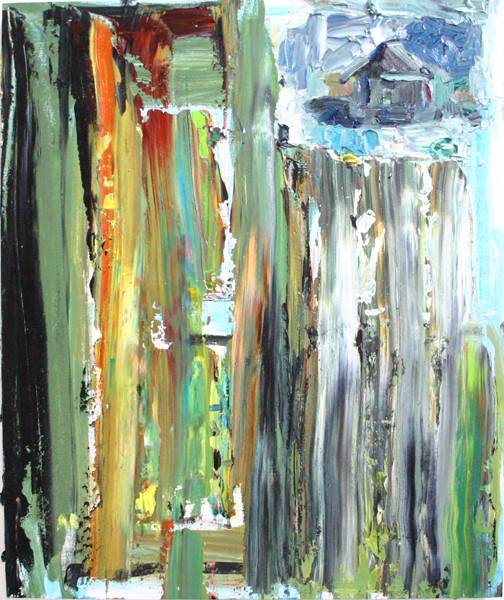Norbert Prangenberg
22 Jul - 03 Sep 2011
NORBERT PRANGENBERG
Kiss the biest
22 Jully - 3 September, 2011
In our third Norbert Prangenberg exhibition we will be showing small oil paintings and ceramic sculptures.
In Prangenberg's work, drawing, painting, and sculpture are of equal value. Over a period of decades, he has developed his own independent visual world out of a vocabulary of simple forms. Cubes, circles, rhombuses, and angles form the starting point for a constant process, an exploration of the elements of color, form, and structure. In 2007 Prangenberg began working once again with painting. Through the most traditional of media, oil paint, he is attempting to re-define painting yet again.
Various themes can be discerned in his current works. The series of Robinson paintings deals with the literary myth of the lone outsider. For the first time, there are approaches to figurativeness in Prangenberg's painting, although the works do not take on a narrative quality. For instance, one can make out the sketchy outlines of a hut or palms. As postcard-sized islands, pictures within a picture, hints of objects are clearly separated from the surrounding informal painting. Here, the materiality of the paint is expressed through thick impasto and intense brilliance.
Painting and drawing cross genres to combine in the series of stag pictures. The stag is the quintessential trivial theme, but also represents Romantic myth and is considered a symbol of masculinity; sketched in pencil, it becomes a gentle contour on a flat ground, an intriguing exploration of contrasts between line and plane, paint and open ground.
Prangenberg's abilities as an intuitively creative artist are obvious in the abstract paintings. Consciously referring to the long tradition of non-figurative painting, he creates new visual forms that gain strength from his immediate, dynamic painting technique, while at the same time they carry Prangenberg's unmistakable signature.
Correspondingly, the sculptures also demonstrate a new way of dealing with clay. Raw and almost unprocessed, these organic and vegetable constructs seem to grow of their own accord. Many fingerprints remain visible. Hidden inside, or set marginally on the surface, the figures conceal a secret: delicately worked shards of majolica, quotations from the history of ceramics.
Norbert Prangenberg, born 1949 in Rommerskirchen-Nettesheim, Germany, lives and works in Niederarnbach and Munich. He has been a professor for ceramics and glass at the Kunstakademie in Munich since 1993. Selected solo shows: Kunstmuseum Kloster Unser Lieben Frauen, Magdeburg, 2008; Staatliche Kunsthalle, Karlsruhe, 2005; Kaiser Wilhelm Museum, Krefeld, 2004; Württembergischer Kunstverein, Stuttgart; Westfälischer Kunstverein, Münster, 1996/97; Museum Haus Lange, Krefeld, 1984. His work has been shown at the 1986 Sydney Biennial and the seventh Documenta in Kassel, 1982. Prangenberg's works can be found in renowned collections, including the Bayerische Staatsgemäldesammlung, Pinakothek der Moderne, Munich; the Graphische Sammlung at the Ludwig Museum in Cologne, and the Lauffs Collection.
Kiss the biest
22 Jully - 3 September, 2011
In our third Norbert Prangenberg exhibition we will be showing small oil paintings and ceramic sculptures.
In Prangenberg's work, drawing, painting, and sculpture are of equal value. Over a period of decades, he has developed his own independent visual world out of a vocabulary of simple forms. Cubes, circles, rhombuses, and angles form the starting point for a constant process, an exploration of the elements of color, form, and structure. In 2007 Prangenberg began working once again with painting. Through the most traditional of media, oil paint, he is attempting to re-define painting yet again.
Various themes can be discerned in his current works. The series of Robinson paintings deals with the literary myth of the lone outsider. For the first time, there are approaches to figurativeness in Prangenberg's painting, although the works do not take on a narrative quality. For instance, one can make out the sketchy outlines of a hut or palms. As postcard-sized islands, pictures within a picture, hints of objects are clearly separated from the surrounding informal painting. Here, the materiality of the paint is expressed through thick impasto and intense brilliance.
Painting and drawing cross genres to combine in the series of stag pictures. The stag is the quintessential trivial theme, but also represents Romantic myth and is considered a symbol of masculinity; sketched in pencil, it becomes a gentle contour on a flat ground, an intriguing exploration of contrasts between line and plane, paint and open ground.
Prangenberg's abilities as an intuitively creative artist are obvious in the abstract paintings. Consciously referring to the long tradition of non-figurative painting, he creates new visual forms that gain strength from his immediate, dynamic painting technique, while at the same time they carry Prangenberg's unmistakable signature.
Correspondingly, the sculptures also demonstrate a new way of dealing with clay. Raw and almost unprocessed, these organic and vegetable constructs seem to grow of their own accord. Many fingerprints remain visible. Hidden inside, or set marginally on the surface, the figures conceal a secret: delicately worked shards of majolica, quotations from the history of ceramics.
Norbert Prangenberg, born 1949 in Rommerskirchen-Nettesheim, Germany, lives and works in Niederarnbach and Munich. He has been a professor for ceramics and glass at the Kunstakademie in Munich since 1993. Selected solo shows: Kunstmuseum Kloster Unser Lieben Frauen, Magdeburg, 2008; Staatliche Kunsthalle, Karlsruhe, 2005; Kaiser Wilhelm Museum, Krefeld, 2004; Württembergischer Kunstverein, Stuttgart; Westfälischer Kunstverein, Münster, 1996/97; Museum Haus Lange, Krefeld, 1984. His work has been shown at the 1986 Sydney Biennial and the seventh Documenta in Kassel, 1982. Prangenberg's works can be found in renowned collections, including the Bayerische Staatsgemäldesammlung, Pinakothek der Moderne, Munich; the Graphische Sammlung at the Ludwig Museum in Cologne, and the Lauffs Collection.

